Crossfire: The Plot That Killed Kennedy (65 page)
Read Crossfire: The Plot That Killed Kennedy Online
Authors: Jim Marrs


Evidence of disappearing assassination clues can be found
in this photograph of a sandyhaired man picking up what
was described as a bullet slug
which struck the grass on the
south side of Elm Street. The
man was identified by Dallas
Police Chief Jesse Curry as
an FBI agent. The policeman
in the background, J. W. Foster, saw the bullet hit the
ground during the assassination from his position on the
Triple Underpass. A superior
told him to guard this evidence, which he did until it
was taken by the agent. No
official explanation of this extraneous bullet has ever been
made, although a photograph
of its location was published
in a Dallas-area newspaper the
day after the assassination.
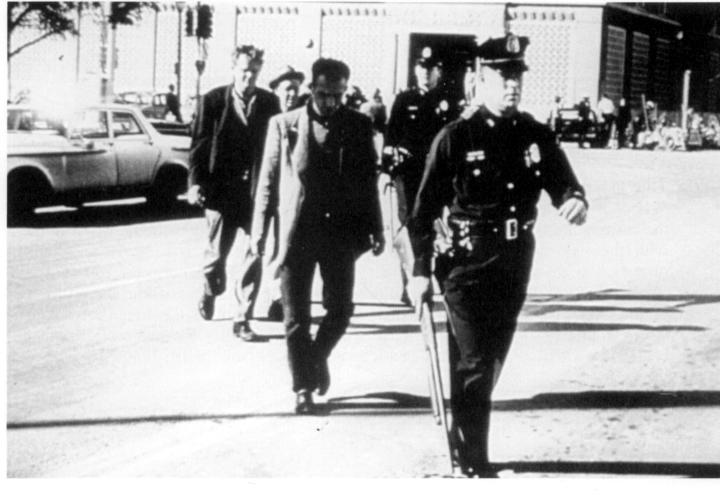
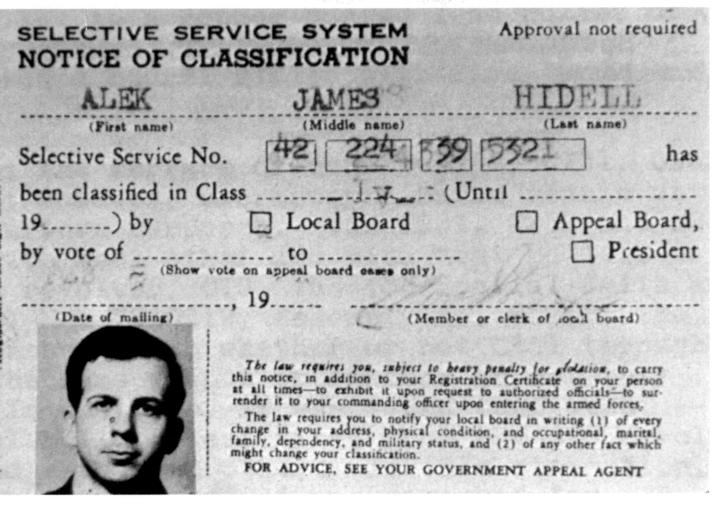
(Above) Circumstances might well point
to the truth of who was behind Kennedy's
death. For example, two hours after
the assassination Lee Harvey Oswald refused to tell Dallas police his real identity. He carried identification in the name
of Oswald and of Alek James Hidell (seen
above). The Dallas authorities were unsure of even the name of their recentlycaptured suspect. Yet, according to FBI
documents released in 1977, at this same
time, Bureau Director J. Edgar Hoover
telephoned Attorney General Robert Kennedy with a full rundown on Oswald and
his background in the Marines and in
Russia. Hoover assured Kennedy that
Oswald was the assassin and styled him
as a "mean-minded individual . . . in
the category of a nut."
(left, bottom) Although more than a dozen
persons were arrested in Dealey Plaza in
the minutes following Kennedy's assassination, most were released without question after the capture of Lee Harvey
Oswald. Over the years researchers have
claimed that one of three "tramps" shown
here being escorted to the Sheriff's Office under arrest may have been CIA
officer E. Howard Hunt (man in rear
with hat), a charge Hunt denied. Much
evidence suggests that the taller "tramp"
(on left) may have been convicted Texas
hitman Charles V. Harrelson. Harrelson
too denies any involvement. The truth of
these suspects' identities may never be
known because arrest records from the
Dallas Police and Sheriff's Office for that
day are missing from the National Archives.
Evidence of suppression of
evidence by authorities is
here in the backyard photos of Lee Harvey Oswald.
Top left and center are the
pictures reportedly discovered by Dallas Police on
November 23, 1963 and
soon sold to Life under
unusual circumstances.
These two photos were also
published by the Warren
Commission as evidence of
Oswald's guilt (Commission Exhibits 133-A and
133-B). On the right, is a
third backyard photograph
which was only discovered
in 1976. Notice that when
Dallas police reenacted the
backyard photograph for the
Commission (bottom), they
used the pose of the third
photo which was kept from
the public for 13 years.
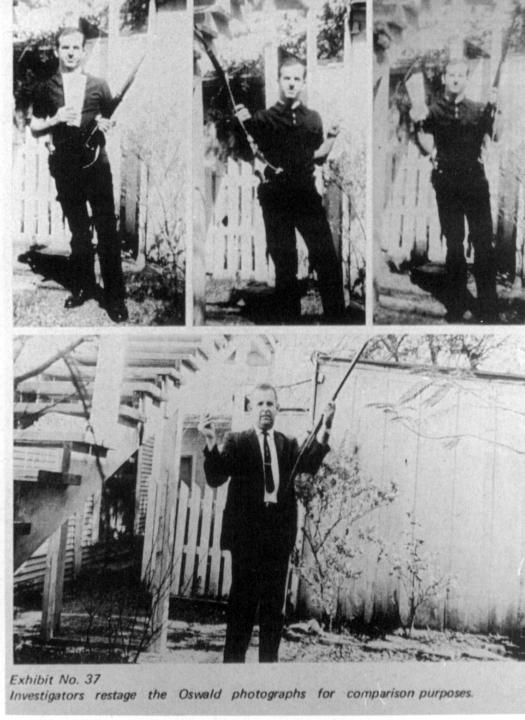
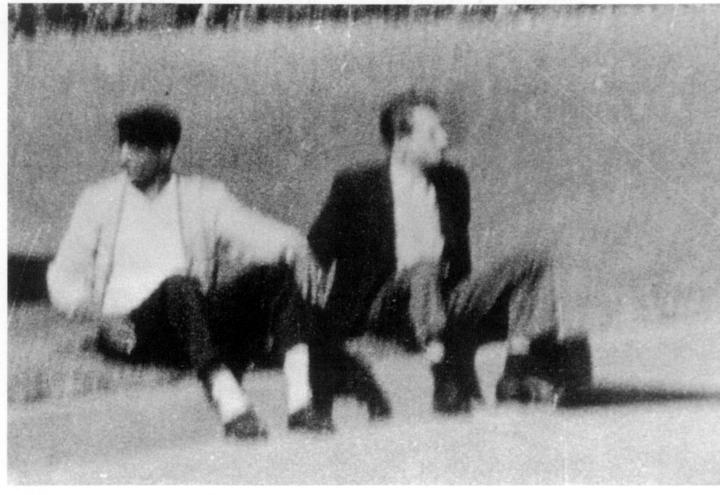

Jean Hill, perhaps the closest bystander to Kennedy at the moment of the fatal
head shot, claims to have witnessed a gunman fire from behind the picket fence on
the Grassy Knoll. But when she tried to pursue the gunman, she was stopped by
two men with Secret Service identification who forcibly took her to other agents in
a building overlooking the assassination site. She said she was intimidated by a
Warren Commission attorney and was kept under surveillance for years after by
the FBI.
DICK BOTHUN from JACK WHITE Photoanalysis
(left, bottom) Above are two of the most suspicious characters in Dealey Plaza
at the moment of the assassination. The man on the right has become known as
the "umbrella man" because just prior to Kennedy's arrival he stood in the warm
sunshine with an open, black umbrella. As Kennedy was first shot, the man
pumped the umbrella up and down as demonstrated in movie films made that day.
Then seconds after the final shots, he joined this dark-complexioned man on the
Elm Street curb. His folded umbrella lies on the ground by his left foot. In other
photos, the second man on the curb appears to be speaking into a walkie-talkie.
For almost twenty years the Federal Government failed to identify either of these
men and made no mention of them in its official reports.

This 30.06 bullet has been fitted with an accelerator or "sabot", a small plastic
device which allows a smaller caliber slug to be fired from a larger shell casing.
Using such a device, the smaller slug will have increased velocity resulting in
explosive striking power identical to what is viewed in the Zapruder film of the
Kennedy assassination. The smaller slug also could have been previously fired and
recovered, resulting in ballistic markings which match the original weapon and not
the 30.06 which fired the "sabot" slug. Some researchers believe such a device
was used to produce bullet fragments traceable to Lee Harvey Oswald's rifle. A
30.06 shell casing indicating the use of a "sabot" was found in the 1970s on the
roof of the Dallas County Records Building overlooking Dealey Plaza.
(Right) Jack Ruby, shown here in Dallas Police custody, was far from being the
insignificant nightclub owner described by the Federal Government. Ruby had
solid contacts with many Dallas police and government authorities, including
District Attorney Henry Wade as well as connections to organized crime figures in
Chicago, New Orleans and Miami. In 1959, while involved with gunrunning
activities involving Cuba, Ruby was an informant for the FBI.

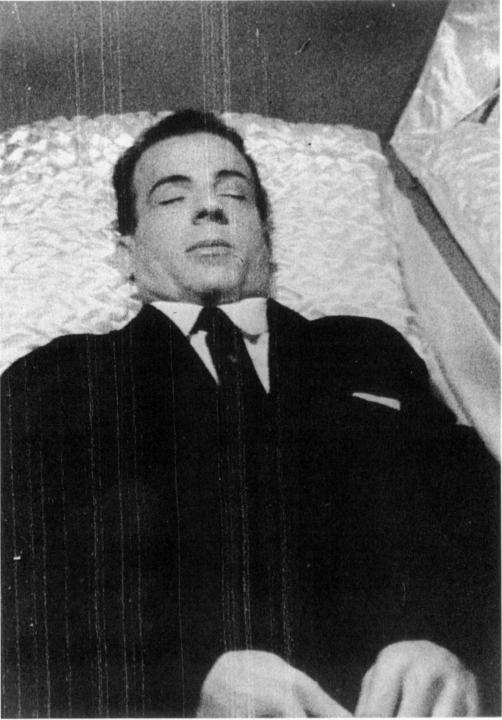
Questions about the identity of Lee Harvey Oswald arose immediately after
his death at the hands of Jack Ruby. Police officials even opened his casket
shortly before burial because of rumors that the casket was empty and his
body spirited away. This picture of Oswald in his casket was made early on
the morning of November 25, 1963, by a Dallas area police official.
Although disputed as an authentic photo of Oswald when first made public
in 1981, the FBI later released Bureau photos of Oswald in his casket
which matched this picture. While the Oswald killed in Dallas was definitely
buried in Rose Hill Cemetery in nearby Fort Worth and despite an official
exhumation of his body in 1981, controversy over the true identity of
Oswald continues today.
